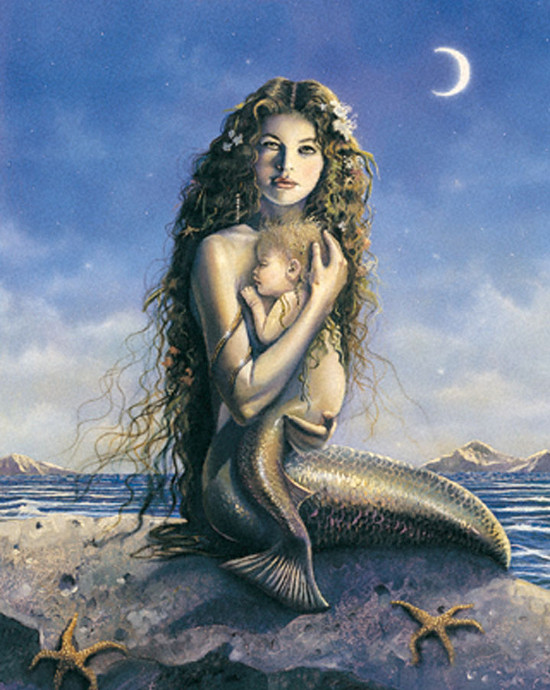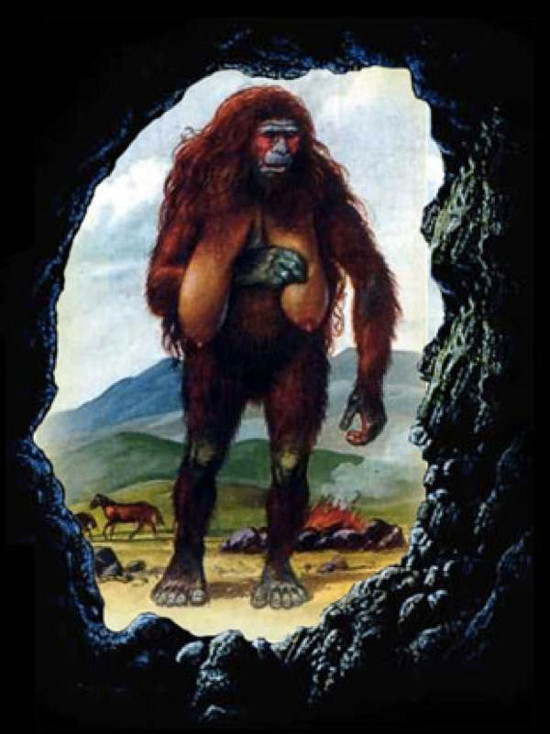10 legendary animals can be real
Many animals are considered extinct or unclear but still persist in many different cultures.
Here is a list of 10 legendary animals that many still believe they exist:
10. The sea of Ilkai

Ilkai is the name used by tribes in Papua New Guinea to refer to a humanoid marine creature.
Ilkai is the name used by tribes in Papua New Guinea to refer to a humanoid marine creature like the mermaids commonly mentioned in the West. Although the existence of this species may be absurd from an evolutionary point of view, there are still many articles and rumors recorded from the local people.
In 1983, zoologist Richard Greenwell and anthropologist Roy Wagner, from the United States, organized an exploration of an 'often seen Ilkai people' area , hoping to discover the mysteries of the sea in legend. . They first thought that the creatures were sea cows (dugong), seals, dolphins, and local people looked wrong.
However, after witnessing firsthand these mysterious creatures chasing small fishes in a bay, Greenwell and Wagner came to the conclusion that Ilkai is truly an unknown species, and the Aborigines know how to distinguish very clear between this sea and other marine mammals. Unfortunately, the remoteness of the area and the lack of funds meant that the team had to abruptly end the expedition, and Papua New Guinnea's seas were still a mystery to this day.
9. The Almas

Almas people have small stature, strong muscles, their hair is full and there is no language.
Almas is a wild 'animal - beast' living in the mountains of Kazakhstan and Mongolia. As described, they are somewhat similar to prehistoric people: small physique, strong muscles, full of hair and no language. The rumors of the Almas have been circulating for several hundred years and the locals consider them to be a clan of people living in this land.
In 1925, a cavalry unit under the Red Army led by General Mikhail Stephanovitch Topilski went through a cave here. After the army fired several rounds into the cave because the enemy suspected of hiding there, an animal like a naked person ran out screaming, then died of bullet wounds. Topilski recorded in detail, describing his body's fur-shaped body, strong muscles, and monkey-like facial expressions.
In one case, Zana, an Almas woman, was captured by a hunter in a remote village in Georgia's Zadan mountains. Zana was domesticated, living with a hunter and giving birth to three sons, had extraordinary strength. Zana died in 1880 and the children died long ago, leaving no descendants. The tomb of the youngest son has been unearthed and Soviet scientists have analyzed his DNA and found that there are many differences compared to the human genome.
8. Agogve people

Many believe that the Agogve are the remnants of the Australopithecus race.
The Agogve in Kenya and Uganda have some similarities with the Almas, but their stature is smaller and is often described as vertical bonobo monkeys with some human-like features such as long, slender bodies. British explorer and hunter J. Cottnay tried to hunt down Agogve people, but indigenous residents insisted on helping him, not pointing, not leading the way, not revealing information. they know.
The same thing happened in 1983, when a group of British zoologists were prevented by the local people from arresting a strange-looking village resident called 'the ancestor of men '. Many believe that the Agogve are the remnants of the Australopithecus race, living in Africa about 4 million years ago.
7. Yeren people (young people)

The Yeren people have a dark orange coat.
You don't need to imagine what a Snowman is (Yeti and Bigfoot). China, which also has its own version of an elusive, elusive creature, like an orangutan, is too large to hide in the deep forest and remote mountain ranges that people call the Yeren (the young man).
Unlike the Bigfoot in North America, the Yeren have a dark orange coat. According to local people, the Yeren are not as shy as their North American brothers. In a report from 1942, when the Sino-Japanese war occurred, Mr. Liu Jikuan, at that time, saw an army regiment passing through his village capture two yerens, chains and drag on the road. Now sometimes people say that they have seen yeren people in remote areas of China.
6. The Megalania Prisca

Although extinct for a long time, there are often people informing the government to see this giant lizard species.
The giant Megalania Prisca, formerly known as Varanus Priscus , is a prehistoric species, much larger than Indonesia's Komodo dragon, often wandering in Australia's outlying areas, terrorizing animals. native objects. Despite knowing that Megalania has become extinct long ago, it is often reported to the authorities that the giant lizard (Australia called goanna) is about the same size as a saltwater crocodile.
For example, in 1939, a train passing through New South Wales had to stop in the middle of the road because of a huge crowd gathered on the tracks. It is known that the crowd is looking together for an estimated giant lizard about 8 meters long.
More recently, in 1979, an Australian doctor Frank Gordon encountered a giant lizard running in front of his jeep at great speed while he was traveling alone in the mountains. northern New South Wales.
5. The Kongamato

Kongamato is a mysterious object living in deep marshes and directed African rainforests.
Kongamato is a mysterious object that lives in deep swamps and tropical African rainforests, a special area that mysterious animal researchers (cryptozoolog) are very interested in regularly getting informed about. strange creatures appear. Kongamato is like a prehistoric bird (pterodactyl) with a wingspan of about 2 meters and is considered an endemic animal of this region. It is very strong, sharp teeth, cannot be a misidentified bird but an unknown bird.
In 1932, the famous explorer Ivan Sanderson organized an expedition into remote areas of Cameroon. One day, he and his team shot down an unusual animal that flew over their heads. It described it as a blend of bats, birds and reptiles. Soon after, the strange animal attacked the adventurers, causing them to flee.
Local tribes said they had to live in the persecution of kongamato, which they considered as messengers of death, far more dangerous than lions, leopards, or black mamba, extremely poisonous. Field surveys are very difficult and the data collected about this dinosaur-like animal is presented in the African Equatorial Scientific Journal.
4. Orangutan Pendek

This creature is just like a monkey and a human (small body, extraordinary strength), it is shy, avoiding contact with people.
The animal that lives in Sumatra that the locals call orangutan Pendek (Orang Pendek) is somewhat like a Snowman, but it is not very big. Deep in the primitive forests of Sumatra island, it is both akin to a monkey and a human (small body, extraordinary strength), shy, avoiding contact with people. The Dutch colonists who ruled here at the beginning of the century described it as a short-haired creature, unlike orangutans or gibbons but quite similar and capable of going upright.
3. The Yowie

Yowia is considered by many to be an Australian Snowman version.
Yowia is considered by many to be an Australian Snowman, meaning a 'cousin' with the legendary animal known to the world but living in another continent. The reason is that the environment in Australia does not seem to be suitable for this great omnivorous primate to exist.
However, rumors about the appearance of the animal sometimes rise. One of the most buzzing times was the announcement of Senator Bill O'Chee, Australia's Queensland National Party.
In 1977, when Mr. O'Chee was still in school, on a two-day excursion near Springbook, he and his friends had been harassed by a creature of up to 3m height, a face resembling a gorilla monkey, pulling trees from below. Incredibly easy land. His group had seen the animal many times during the two days and O'Chee still remembered what he had witnessed.
For him and many other Australians who saw this animal, the mythical Yowie is real and still lives in the remote areas of Australia's Gold Coast region.
2. Giant forest cat Nunda

The Nunda is said to be a giant cat, hiding in forests in Tanzania.
The Nunda is said to be a giant cat, hiding in Tanzania's forests, its stature and strength are much greater than any lion. It is worth noting that its fur samples that it was collected confirmed that it is actually a completely new carnivore.
In 1922, William Hichens, a native of Lindi, first noticed the animal in Europe based on information from some of his acquaintances, saying they had been attacked by it. In 1920, a Scottish hunter Patrick Bowen tried to hunt down the nunda but did not meet. However, he recognized the animal's footprints and its fur patterns, belonging to a species that science had never known. Although there have been many cases of nundas attacking people in this area, since then there have been many hunting missions to come but no one has succeeded.
1. The Acurinis tribe

This mysterious tribe is completely different from the tall, blonde, Europeans in the middle of the dense jungle of the tropical rainforest.
The existence of the mysterious tribes is completely different from the tall, blond Europeans in the middle of the jungle of the tropical rainforest, where no one of the civilized world has arrived. making acurinis worthy of adding to the list of 'mysterious people'. It was not until 1977 that the first contact with this unidentified tribe was close to the springs of the Araguaya River, where the Anglo-Brazilian expedition found itself surrounded by tall aborigines blond, naked said a dialect unlike any Indian tribe. In 1979, there was another brief encounter with the acurinis, the members of the second expedition were shocked by the stature and color of the tribal members.
One can ask the question: Why are these tribal data so few? One answer might be: The Brazilian government is trying to hide its existence to continue to reclaim the land of the Indians that the world does not pay attention to.
- Why is there absolutely no three-legged creature on Earth?
- Animals are 100% real but identical
- The legendary king used 300 people to beat
- Hobbit may be one of the earliest people on Earth
- Listen to the weird 'real voice' of animals
- Where did 12 Giap come from?
- 3 'legendary' dogs in world history
- Synthesis of the best news from June 3, 2017
- New hypothesis: The legendary city of Atlantis lurks in the heart of the Sahara desert
- Italy successfully tested the first robot
- The legendary mermaid statue is 100 years old
- Is the 'Pirate Island' real-life version disappointing One Piece fans?
 Animal 'suffering' after hibernation
Animal 'suffering' after hibernation Why do goats climb well?
Why do goats climb well? Scientists were surprised to see chimpanzees eating turtles
Scientists were surprised to see chimpanzees eating turtles Giant catfish died deadly due to drought in Thailand
Giant catfish died deadly due to drought in Thailand